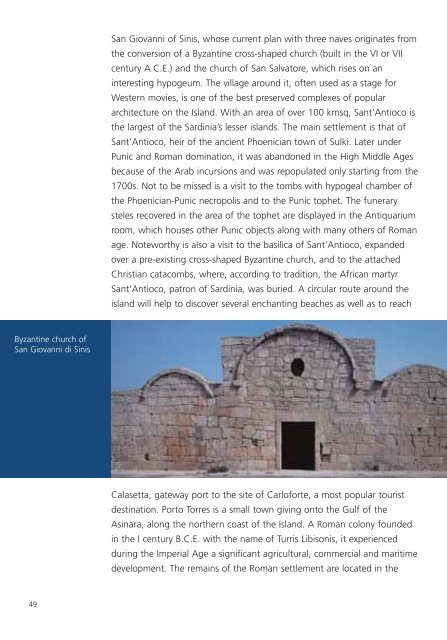Create successful ePaper yourself
Turn your PDF publications into a flip-book with our unique Google optimized e-Paper software.
San Giovanni of Sinis, whose current plan with three naves originates from<br />
the conversion of a Byzantine cross-shaped church (built in the VI or VII<br />
century A.C.E.) and the church of San Salvatore, which rises on an<br />
interesting hypogeum. The village around it, often used as a stage for<br />
Western movies, is one of the best preserved complexes of popular<br />
architecture on the Island. With an area of over 100 kmsq, Sant’Antioco is<br />
the largest of the Sardinia’s lesser islands. The main settlement is that of<br />
Sant’Antioco, heir of the ancient Phoenician town of Sulki. Later under<br />
Punic and Roman domination, it was abandoned in the High Middle Ages<br />
because of the Arab incursions and was repopulated only starting from the<br />
1700s. Not to be missed is a visit to the tombs with hypogeal chamber of<br />
the Phoenician-Punic necropolis and to the Punic tophet. The funerary<br />
steles recovered in the area of the tophet are displayed in the Antiquarium<br />
room, which houses other Punic objects along with many others of Roman<br />
age. Noteworthy is also a visit to the basilica of Sant’Antioco, expanded<br />
over a pre-existing cross-shaped Byzantine church, and to the attached<br />
Christian catacombs, where, according to tradition, the African martyr<br />
Sant’Antioco, patron of Sardinia, was buried. A circular route around the<br />
island will help to discover several enchanting beaches as well as to reach<br />
Byzantine church of<br />
San Giovanni di Sinis<br />
Calasetta, gateway port to the site of Carloforte, a most popular tourist<br />
destination. Porto Torres is a small town giving onto the Gulf of the<br />
Asinara, along the northern coast of the Island. A Roman colony founded<br />
in the I century B.C.E. with the name of Turris Libisonis, it experienced<br />
during the Imperial Age a significant agricultural, commercial and maritime<br />
development. The remains of the Roman settlement are located in the<br />
49
















